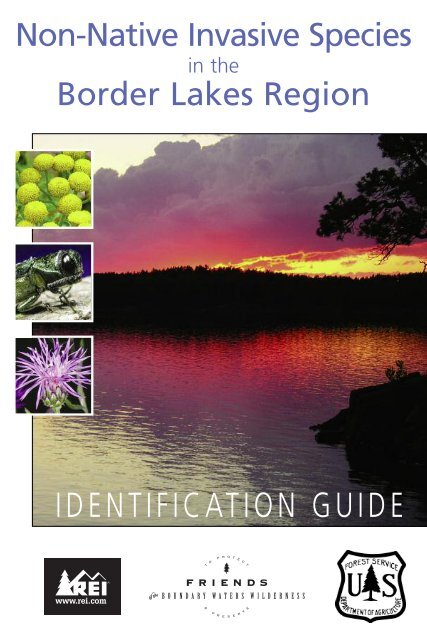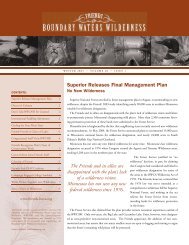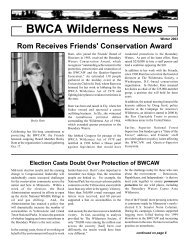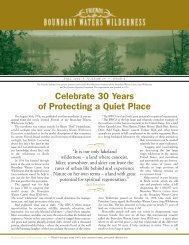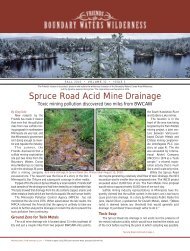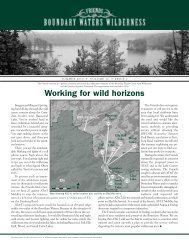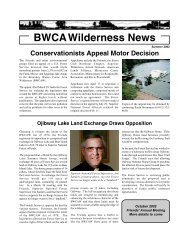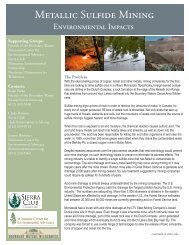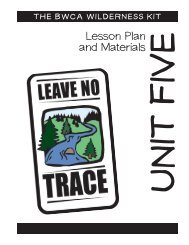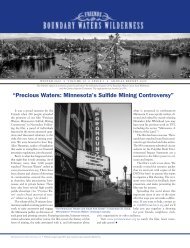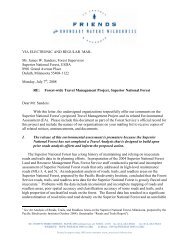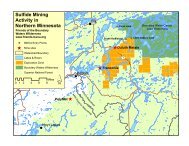IDENTIFICATION GUIDE - Friends of the Boundary Waters Wilderness
IDENTIFICATION GUIDE - Friends of the Boundary Waters Wilderness
IDENTIFICATION GUIDE - Friends of the Boundary Waters Wilderness
You also want an ePaper? Increase the reach of your titles
YUMPU automatically turns print PDFs into web optimized ePapers that Google loves.
FRIENDS OF THE BOUNDARY WATERS WILDERNESS401 N THIRD STREET, SUITE 290MINNEAPOLIS MN 55401-9714POSTAGE WILL BE PAID BY ADDRESSEEBUSINESS REPLY MAILFIRST-CLASS PERMIT NO. 25304 MINNEAPOLIS, MNNO POSTAGENECESSARYIF MAILEDIN THEUNITED STATESWhy should I care aboutNon-Native Invasive Species(NNIS) in <strong>the</strong> Border LakesRegion?• If left unchecked, invasive species will limit many uses <strong>of</strong> ourlands and waters.• Invasive species can harm <strong>the</strong> natural heritage <strong>of</strong> ourwetlands, forests, lakes and rivers.• Invasive species can limit our opportunities for hunting,fishing, camping, wildflower viewing, bird watching, boating,and o<strong>the</strong>r recreational pursuits.• Invasive species can damage <strong>the</strong> ecological integrity <strong>of</strong> <strong>the</strong>region by transforming fish and wildlife habitat.• The longer we ignore non-native invasive species, <strong>the</strong> moredifficult and expensive <strong>the</strong>y will be to eradicate.• You can be a part <strong>of</strong> <strong>the</strong> solution by being aware <strong>of</strong> invasiveplants and animals and taking action to prevent <strong>the</strong>ir spread.What are Non-NativeInvasive Species?NNIS are species that are not indigenous to an area and thatcause harmful effects to its economy, <strong>the</strong> environment, or humanhealth. Not all non-native species are invasive – for example,most common garden plants are attractive, do not spreadaggressively, and do no harm. Just a fraction <strong>of</strong> non-nativespecies are invasive, but those that are tend to be aggressive anddifficult to control. They reproduce rapidly and cause majorchanges to areas where <strong>the</strong>y become established.1
NNIS can be plants or animals, and <strong>the</strong>y can be aquatic orterrestrial. Examples <strong>of</strong> non-native invasive plants that havebeen found on <strong>the</strong> Superior National Forest are commonbuckthorn, Canada thistle, purple loosestrife, spotted knapweed,and leafy spurge. Examples <strong>of</strong> non-native invasive animals aregypsy moth, spiny water flea, and rusty crayfish.Nationally, NNIS cause major environmental damage and lossestotaling $120 billion/year. Non-native invasive plants aloneinfest about 133 million acres across <strong>the</strong> U.S., about <strong>the</strong> size <strong>of</strong>California and New York combined.How bad is <strong>the</strong> problem in <strong>the</strong>Border Lakes Region?We have a unique opportunity to limit <strong>the</strong> negative economic,environmental, and social impacts caused by NNIS in <strong>the</strong>Quetico-Superior. Compared to o<strong>the</strong>r states or provinces, ourregion has relatively low levels <strong>of</strong> NNIS infestation. However,this could change quickly without your help.With <strong>the</strong> BWCAW being <strong>the</strong> most heavily visited wilderness areain <strong>the</strong> U.S., and with all <strong>the</strong> recreational opportunities that existin <strong>the</strong> Arrowhead Region <strong>of</strong> Minnesota and in northwestOntario, <strong>the</strong> area attracts hundreds <strong>of</strong> thousands <strong>of</strong> visitors everyyear from around <strong>the</strong> world. And with <strong>the</strong>se visitors comes <strong>the</strong>potential for unwanted hitchhikers – such as gypsy moth oremerald ash borer hidden on/in firewood, spiny waterflea onboating equipment, or spotted knapweed on muddy vehicletires.Why should fishermenand boaters care aboutnon-native species?Voyageurs National Park, Superior National Forest (including <strong>the</strong>BWCAW) and Quetico Provincial Park have some <strong>of</strong> <strong>the</strong> mostpristine lakes in <strong>the</strong> U.S. or Canada. Fishing and boating are two<strong>of</strong> <strong>the</strong> major attractions in <strong>the</strong> region, but non-native invasivespecies can cause a reduction in fish populations, damagefisheries, and make boating a challenge.Spiny water flea is an example <strong>of</strong> a non-native invasive animal.It is a small, spine-covered crustacean that has <strong>the</strong> potential todisrupt aquatic food webs and impact fish populations. Spinywater fleas can reproduce much faster than o<strong>the</strong>r nativezooplankton and may outcompete o<strong>the</strong>r species in somesituations. Spiny water flea may also compete directly withyoung fish for food.Rusty crayfish, ano<strong>the</strong>r NNIS, may impact fish populationsthrough <strong>the</strong> destruction <strong>of</strong> aquatic plants which provideimportant habitat for many fish species. Aquatic plant beds arean important part <strong>of</strong> rivers and lakes, and destruction <strong>of</strong> <strong>the</strong>seplant beds can impact habitat for young fish, which depend on<strong>the</strong>m for cover and as places to feed. Rusty crayfish are presentin a number <strong>of</strong> lakes in <strong>the</strong> BWCAW, Quetico, and VoyageursNational Park.Eurasian water milfoil, an invasive plant, negatively affectsrecreational activities, fish habitat, and native plant diversity.This aquatic invasive plant tends to grow in dense floating matsand may become entangled in boat propellers, clog waterintakes, and pose a hazard to swimmers. Eurasian water milfoilalso outcompetes native aquatic plants which provide important2 3
fish habitat and plant diversity in lakes, rivers, and streams. In<strong>the</strong> winter, large populations <strong>of</strong> dead and decaying Eurasianwater milfoil may contribute to reduced oxygen levels in lakeswhich may lead to over-winter fish kills.Here’s what you can do to help:• Inspect your boat, trailer, and boating equipment and removeany plants and animals that are visible before leaving anywater body.• Drain water from <strong>the</strong> motor, live well, bilge, and transomwells while on land before leaving any water body.• Dispose <strong>of</strong> unwanted bait such as minnows or worms in <strong>the</strong>trash. Never release live bait into a waterbody.• Wash and dry your boat, tackle, downriggers, trailer, ando<strong>the</strong>r boating equipment to kill harmful species that you mayhave missed at <strong>the</strong> boat launch.Even a small amount <strong>of</strong> plant material or animals can start anew infestation. Take precautions to protect <strong>the</strong> lakes andstreams that you treasure.Why should campers, hikers,mountain bikers, or ATVerscare?The solitude and beauty <strong>of</strong> <strong>the</strong> border lakes region are why manypeople come here to visit from across <strong>the</strong> country and around<strong>the</strong> world. Invasive species can significantly impact your abilityto access and enjoy <strong>the</strong> outdoors. Campsites and portages canbe infested by dense stands <strong>of</strong> Canada thistle, making passage apainful experience. Lakes can become dense mats <strong>of</strong> Eurasianwater milfoil, making paddling a challenge and swimming risky.Scenic beauty can also be reduced due to invasive plants. Forexample, orange hawkweed and oxeye daisy can form densepatches and displace native wildflowers, thus forming standswith just a few species ra<strong>the</strong>r than a vast assortment <strong>of</strong>wildflowers to enjoy.Gypsy moths have been found recently in <strong>the</strong> Superior NationalForest. One gypsy moth can eat up to one square foot <strong>of</strong> leavesa day. This weakens trees and destroys <strong>the</strong> natural beauty <strong>of</strong> <strong>the</strong>landscape. The weakened trees are also more susceptible todisease and pests, which may <strong>the</strong>n kill <strong>the</strong>m. Ecosystems can bealtered if gypsy moth populations get high enough. Any areathat has a gypsy moth infestation is unpleasant to visit due to<strong>the</strong> caterpillar droppings, and an area may be quarantined ifgypsy moth populations are high enough, thus causing economicimpacts.Here’s what you can do to help:• Clean mud and seeds from all clo<strong>the</strong>s, boots, equipment, andpets.• Remove weed seeds, mud, and plant parts from mountainbike tires and chain, or ATV tires and undercarriage.• Place seeds and plant parts in a bag and dispose <strong>of</strong> in atrash can.• Do not transport firewood. Firewood should be purchasedlocally from an approved vendor or collected on-siteaccording to agency regulations. Check with <strong>the</strong> appropriateagency to determine what firewood regulations apply to you.• Learn how to identify invasive plants and animals and reportany sightings to local land managers.4 5
Why should loggers andforesters care?Invasive plants can greatly impact <strong>the</strong> health and regeneration<strong>of</strong> forest lands. For example, garlic mustard can rapidly spreadinto <strong>the</strong> understory <strong>of</strong> hardwood stands, and has been shown tosuppress o<strong>the</strong>r understory plants, which may reduce treeseedling establishment.Japanese barberry, an invasive shrub, not only crowds out o<strong>the</strong>rplants, but also alters soil conditions to its benefit. Deer avoideating this spiny shrub, which means <strong>the</strong>y browse more onnative trees, slowing <strong>the</strong> growth <strong>of</strong> seedlings or even killing<strong>the</strong>m. Dense thickets <strong>of</strong> Japanese barberry or o<strong>the</strong>r invasiveshrubs like Tatarian honeysuckle displace native plants and <strong>the</strong>wildlife that depend on <strong>the</strong>m.Common buckthorn and its slightly smaller relative glossybuckthorn both grow as shrubs or small trees. Originally used asornamental shrubs, <strong>the</strong>y <strong>of</strong>ten escape cultivation and becomedominant in forest understories. Common buckthorn has thornsand can form a nearly impenetrable thicket. Both compete withnative trees to slow <strong>the</strong>ir growth.Most invasive plants depend on some kind <strong>of</strong> disturbance to <strong>the</strong>soil or ground cover to get established in <strong>the</strong> forest. Forestmanagement activities, such as timber harvest or sitepreparation for tree planting, can create opportunities for nonnativeinvasives to get established and spread. Invasive plantspresent in small numbers prior to forest management activitymay explode in growth following management activity.Non-native invasive insect pests like gypsy moth defoliate treesand stress <strong>the</strong>m, causing increased mortality and decreasedgrowth. O<strong>the</strong>r non-native insects like emerald ash borer killtrees by eating through parts <strong>of</strong> <strong>the</strong> wood that transport sap.These pests can impact timber production as well as residentialtrees. In some cases, an area will be quarantined and transport<strong>of</strong> commercial forest and nursery products is restricted.Since loggers and foresters rely on <strong>the</strong> long-term supply <strong>of</strong> forestresources, it is in <strong>the</strong>ir best interest to ensure <strong>the</strong> healthyregeneration <strong>of</strong> forest stands to native tree species.Here’s what you can do to help:• Learn to identify invasive plant species and watch for <strong>the</strong>m.The sooner invasive plants are detected, <strong>the</strong> easier andcheaper it is to control <strong>the</strong>m.• Initiate control <strong>of</strong> invasive plant species before harvestactivities take place. Invasive plant populations quicklyexplode after disturbance to <strong>the</strong> forest canopy and soils.Controlling invasive plants before harvest is a good way toavoid this dramatic increase.• Clean timber harvesting equipment before it comes onto anew job site to prevent <strong>the</strong> transport <strong>of</strong> seeds <strong>of</strong> invasivespecies caught on tire tread and undercarriages.Why should landowners care?Living in <strong>the</strong> north woods is many people’s dream come true.Invasive species can change that dream very quickly. Once aninvasive species gets established, control and eradication canbecome very difficult and costly. In some parts <strong>of</strong> <strong>the</strong> U.S., <strong>the</strong>presence <strong>of</strong> non-native invasive plants has caused propertyvalues to drop.Many people enjoy watching birds and wildlife from <strong>the</strong>irhomes. Non-native invasive species can degrade wildlife habitatand drive birds and wildlife to areas that are not affected by <strong>the</strong>invasive species.6 7
Gypsy moths have <strong>the</strong> ability to severely damage trees. Over alarge area, loss <strong>of</strong> trees caused by gypsy moths can lead tochanges forest habitat with subsequent changes in lakes andstreams, which are many <strong>of</strong> <strong>the</strong> reasons that people have movedto such areas to begin with. Highly valued residential trees canalso be killed by gypsy moths or emerald ash borer.Early detection <strong>of</strong> non-native invasive species by landowners candramatically increase <strong>the</strong> chances for successfully controllingsuch species later on. By being aware <strong>of</strong> different plant andanimal invaders and contacting resource managers if suchspecies are found, landowners can protect <strong>the</strong> resources that<strong>the</strong>y value such as shade trees, songbird and wildlife habitat, orscenic beauty.Here’s what you can do to help:• Early detection and eradication are <strong>the</strong> most cost effectiveways to manage non-native invasive species. You can helpby taking on <strong>the</strong> responsibility <strong>of</strong> invasive species control onyour property and educating neighbors.• Consult with federal or state agencies on <strong>the</strong> best methodsfor invasive species control.Why should gardeners care?Non-native invasive plant species not only threaten our naturalareas, <strong>the</strong>y may invade your garden! Landscaping shrubs likeTatarian honeysuckle seed so freely into maintained landscapesthat it is a continual challenge to rip <strong>the</strong>m out before <strong>the</strong>y takeover and displace o<strong>the</strong>r species you lovingly planted in yourgarden.Jack Greenlee USDA Forest ServiceThese aggressive species can rapidly move from your land ontoyour neighbor’s land. Working toge<strong>the</strong>r with your neighbors isusually <strong>the</strong> only realistic way <strong>of</strong> managing NNIS infestations.Just because a plant is not spreading in your own garden doesnot mean that <strong>the</strong> seeds from your plants are not spreadingelsewhere. Purple loosestrife seeds, for instance, may wash fromyour yard into storm sewers and nearby waterways andgerminate in moist areas like creek banks and lake shores.Here’s what you can do to help:• Avoid using invasive species in your garden, or get rid <strong>of</strong>invasive species that might already be in your garden.• Don’t share invasive species with o<strong>the</strong>r gardeners.• If you are worried that your garden will lose its luster afterremoving invasives, it is easy to find non-invasive or nativealternatives for invasive landscape plants.Don't move firewood around <strong>the</strong> state -this can spread invasive insects like gypsy moth or emerald ash borer.8 9
Jack Greenlee USDA Forest ServiceNon-Native Invasive Speciesto watch for:Buckthorn(Common buckthorn–Rhamnus cathartica;glossy buckthorn– Frangula alnus)Both species <strong>of</strong> buckthorns aredeciduous shrubs that can reach upto 25 feet in height. They haveelliptical leaves and produceabundant blueberry-sized fruits thatare black when ripe. Buckthornswere introduced to North America for use in hedgerows and forwildlife habitat. Glossy buckthorn primarily invades wetlands andwet prairies but is also found in some forested areas. Commonbuckthorn is an invader <strong>of</strong> forested areas. Buckthorn fruits areconsumed by a variety <strong>of</strong> birds and mammals, which aid in <strong>the</strong>irdispersal. These shrubs form dense thickets that prevent woodyseedling regeneration and may inhibit herbaceous understorygrowth in some areas. Common buckthorn has also beenidentified as an overwintering host for soybean aphids, a pest <strong>of</strong>soybean crops.Jack Greenlee USDA Forest ServiceJack Greenlee USDA Forest ServicePurple loosestrife(Lythrum salicaria)Purple loosestrife is easily recognizedby its purple to magenta, 3 ⁄8 inch longflowers composed <strong>of</strong> five to six petals,and its square stems. It is four to sixfeet tall. This species was introducedas an ornamental from Europe,where it is a minor component <strong>of</strong>wetland vegetation. Here in NorthAmerica, purple loosestrife has escaped cultivation and is presentin wetlands and o<strong>the</strong>r wet areas (streambanks, lakeshores, andditches) in almost every state in <strong>the</strong> U.S. Purple loosestrife formsdense single-species stands that cause a decline in plant diversityand affect wildlife by reducing food and habitat for waterfowl andspawning grounds for fish. A single plant can produce 2.5 millionseeds annually, and <strong>the</strong>se seeds can be transported great distancesby humans, animals, water, and wind. Fireweed is a commonnative plant that is <strong>of</strong>ten mistaken for purple loosestrife, but can bedistinguished by having round stems and flowers with four petals.Jack Greenlee USDA Forest ServiceLeafy spurge(Euphorbia esula)Leafy spurge is a deep-rootedperennial that is native to Eurasia.First recorded in <strong>the</strong> U.S in 1827, itmay have first arrived ei<strong>the</strong>r as anornamental or as a contaminant inagricultural seed. This species is anextremely aggressive invader <strong>of</strong>grasslands that can greatly diminish10 11
<strong>the</strong> economic productivity and biological diversity <strong>of</strong> grasslands. Itdestroys wildlife habitat and rangeland productivity by replacingnative grasses and forbs. Leafy spurge grows up to three feet tall,with inconspicuous yellow-green flowers about 1 ⁄2 inch in diameter.The leaves are long and narrow, and if you break <strong>of</strong>f a leaf or breakopen a stem, you will see milky white sap that is toxic to mostgrazing animals. It flowers in June to July. Seeds are dispersedwhen <strong>the</strong> fruit capsules explode, shooting <strong>the</strong> seeds up to 15 feetaway. A look-alike for this plant in nor<strong>the</strong>ast Minnesota is cypressspurge (Euphorbia cyparissias), which is sometimes used as anornamental, but appears to share many <strong>of</strong> <strong>the</strong> invasive properties<strong>of</strong> its better known cousin leafy spurge.Garlic mustard(Alliaria petiolata)Garlic mustard, an invader <strong>of</strong> forestsacross <strong>the</strong> eastern U.S., is a biennialherb that was introduced fromEurope in <strong>the</strong> 1860’s. During its firstyear <strong>of</strong> growth, <strong>the</strong> plant forms a lowgrowingcluster <strong>of</strong> distinctive kidneyshapedleaves. It grows up to 40inches tall in its second year, and canbe recognized by its four-petaled, 3 ⁄8 inch diameter white flowers andtriangular stem leaves with too<strong>the</strong>d edges. Garlic mustard plantsproduce copious seeds, with as many as 3,000 seeds per plant.These seeds can survive for up to 10 years in <strong>the</strong> soil, creating alasting problem at invaded sites. Garlic mustard alters <strong>the</strong>chemistry <strong>of</strong> <strong>the</strong> soils where it grows by adding chemicals to <strong>the</strong> soilthat prevent <strong>the</strong> growth <strong>of</strong> o<strong>the</strong>r plant species. In invaded areas,garlic mustard forms a single-species carpet on <strong>the</strong> forest floor.Jack Greenlee USDA Forest ServiceJack Greenlee USDA Forest ServiceSpotted knapweed(Centaurea biebersteinii)Spotted knapweed is a biennial orshort-lived perennial with pinkishpurple,thistle-like flowers and stemleaves that are covered with downygrayish hairs. Plants are 1-3 feet tall,with 1-1 1 ⁄4 inch wide flowers. It isbelieved to have been introducedfrom Europe in <strong>the</strong> 1890’s as acontaminant in alfalfa or hay. Since its introduction to NorthAmerica, this species has become one <strong>of</strong> <strong>the</strong> most problematic andwidespread invasive plants in <strong>the</strong> western U.S. and is nowspreading throughout <strong>the</strong> Midwest. Knapweed thrives in disturbedareas and spreads quickly once established. Knapweed isespecially troublesome because <strong>of</strong> its ability to release toxicchemicals from its roots; <strong>the</strong>se chemicals reduce growth andgermination <strong>of</strong> neighboring plants.Jack Greenlee USDA Forest ServiceCanada thistle(Cirsium arvense)Canada thistle is an aggressiveinvader in grasslands, forestopenings, and wetland edges, as wellas a pest in pastures and agriculturalfields. It grows 2-5 feet tall, withflowers 1 ⁄2 to 3 ⁄4 inch in diameter. Thisspecies, which was introducedaccidentally as a contaminant in cropseed, invades natural areas both by vegetative reproduction12 13
through rhizomes and by seed, which can be carried very longdistances by wind and water. Canada thistle competes with o<strong>the</strong>rplants for water and nutrients, causing reductions in plant diversityand crop yields. It is avoided by cattle and eaten infrequently bydeer. Before initiating control efforts for Canada thistle, it isimportant to make sure you can recognize <strong>the</strong> differences betweenthis species and native thistles, like swamp thistle (Cirsiummuticum), which are much less aggressive.Jack Greenlee USDA Forest ServiceErin Heep USDA Forest ServiceSt. John’s wort(Hypericum perforatum)This species is a perennial invader <strong>of</strong>disturbed uplands, grasslands, androadsides. It thrives in dry, shallowsoiledor rocky habitats. St. John’swort was originally introduced fromEurope, and recently has gainedpopularity as an herbal remedy fordepression. It grows up to 2 feet talland has yellow, 3 ⁄4 inch wide flowers that appear in July. The leaves,when held up to <strong>the</strong> light, appear to “perforated” by many lightcoloreddots, and this is how it gets its Latin name “perforatum”.In late summer and fall, <strong>the</strong> fruits and stems are reddish colored,which aids in identification.Jack Greenlee USDA Forest ServiceJack Greenlee USDA Forest ServiceCommon tansy(Tanacetum vulgare)Common tansy is a perennial in <strong>the</strong>sunflower family that grows up t<strong>of</strong>ive feet tall from a large, woodyrootcrown. It grows primarily alongroadsides and o<strong>the</strong>r disturbed areasin nor<strong>the</strong>ast Minnesota. Itscompound leaves are reminiscent <strong>of</strong>a fern, and when crushed <strong>the</strong> leavesgive <strong>of</strong>f a distinctive medicinal odor. Common tansy’s disk-shapedyellow flowers look like a button and are about 1 ⁄2 inch in diameter.This invasive plant flowers in July and August. Common tansy issometimes found in dried flower arrangements and is still soldcommercially as an ornamentalOxeye daisy(Leucan<strong>the</strong>mum vulgare)This member <strong>of</strong> <strong>the</strong> sunflower familyis a perennial with showy whitepetals and a shallow root system.Flowers are about 1 1 ⁄2 inches indiameter. Oxeye daisy has beenintroduced intentionally as anornamental and unintentionally as acontaminant in hay or grain seed.This plant is native to Europe, and it has naturalized in <strong>the</strong>nor<strong>the</strong>astern United States. It is an aggressive competitor and canbe seen forming dense patches along most roadsides innor<strong>the</strong>astern Minnesota, but it will not thrive under shady14 15
Jack Greenlee USDA Forest Serviceconditions. It is <strong>of</strong>ten included in wildflower seed packets, soconsumers should read seed package labels carefully and avoidplanting wildflower mixes with oxeye daisy.Orange and yellowhawkweeds(Hieracium auranticum,H. floribundum, H. pilosella,and H. piloselloides)Along with oxeye daisy, orange andyellow hawkweeds are <strong>the</strong> mostcommon invasive plants innor<strong>the</strong>astern Minnesota. In June,roadsides, fields, and disturbed areasbecome carpets <strong>of</strong> white, orange, and yellow as oxeye daisy andorange and yellow hawkweeds come into bloom. The hawkweedsare perennial plants with basal leaves, and some species arecovered with short, stiff hairs. Their flowers are 3 ⁄4 inch wide. Theycan spread both by creeping roots as well as by seeds that disperseby wind like dandelions. This characteristic allows <strong>the</strong>m to spreadeasily into uninfested areas like <strong>the</strong> BWCAW. They are generallyfound in disturbed areas, but may also thrive in undisturbed areasthat are open and sunny, such as rock outcrops that are commonin <strong>the</strong> BWCAW. There are several native hawkweed species thatcould be confused with <strong>the</strong> non-native ones. The nativehawkweeds have leafy flowering stems, while <strong>the</strong> exotic onesgenerally have nearly leafless flowering stems. The non-nativehawkweeds originate from Europe.Jack Greenlee USDA Forest ServiceAlison Fox University <strong>of</strong> FloridaPlumeless thistle(Carduus acanthoides)This biennial thistle is <strong>the</strong> spiniestthistle in Minnesota! Although itgrows from a taproot and can besuccessfully killed by pulling, be sureto have stout lea<strong>the</strong>r gloves on handbecause <strong>the</strong> stems have spiny wingsfrom top to bottom. Plumelessthistle can grow up to 4 feet tall andlike o<strong>the</strong>r thistles, it has wind-dispersed seed that can travel longdistances. The compact flowers are 1 ⁄2 to 1 inch wide. This speciesis a particular problem in <strong>the</strong> prairie portion <strong>of</strong> Minnesota. The firstpopulations in nor<strong>the</strong>astern Minnesota were detected in 2003, andas a result <strong>of</strong> this early detection, <strong>the</strong>re is still a good chance toprevent this species from becoming widespread in <strong>the</strong> ArrowheadRegion.Eurasian water milfoil(Myriophyllum spicatum)Eurasian water milfoil is a submersedaquatic plant that was firstdiscovered in Minnesota in LakeMinnetonka in 1987. It growsunderwater and can be difficult todistinguish from native water milfoilspecies. Eurasian water milfoiltypically has 12 to 21 pairs <strong>of</strong> leafletson each leaf while <strong>the</strong> nativenor<strong>the</strong>rn water milfoil usually has16 17
Jack Greenlee USDA Forest Servicefive to nine pairs <strong>of</strong> leaflets per leaf. The plants collapse whentaken out <strong>of</strong> water, so <strong>the</strong> best way to count leaflets is to pick apiece <strong>of</strong> <strong>the</strong> plant and place it in a water-filled cup or dish. A singlesegment <strong>of</strong> stem and leaves can take root and form a new plant,so fragments clinging to boats and trailers can help spread thisweed. There are only two known populations <strong>of</strong> this plant in St.Louis County, and none in Lake or Cook Counties yet, so preventing<strong>the</strong> spread <strong>of</strong> this plant is critical.Exotic honeysucklesTatarian honeysuckle(Lonicera tatarica)Morrow’s honeysuckle(Lonicera morrowii)Bell’s honeysuckle(Lonicera x bella – hybrid <strong>of</strong>Morrow’s and Tatarian)The three invasivehoneysuckles are alldeciduous shrubs that have frequently been used as ornamentalplantings in landscaping. They range in height from five to 12 feet,and older plants have shaggy grey bark and hollow stems. Thefragrant, 1 ⁄2 to 3 ⁄4 inch wide flowers are pink, white, or red and turninto red or orange berries that are dispersed by birds. All <strong>of</strong> <strong>the</strong>seexotic honeysuckles are larger than any <strong>of</strong> <strong>the</strong> native honeysuckleshrubs in nor<strong>the</strong>ast Minnesota, which typically grow no higherthan three to four feet tall. The exotic honeysuckles are quiteshade tolerant and will readily invade and displace native forestunderstory shrubs and forbs.Jason Butcher USDA Forest ServiceJeff Gunderson, Univ. <strong>of</strong> MN Sea Grant ProgramRusty crayfish(Orconectes rusticus)These invasive crayfishgrow up to four incheslong (excluding <strong>the</strong>claws) and are knownto be present in 17lakes on <strong>the</strong> SuperiorNational Forest, 8 <strong>of</strong>which border or are found in <strong>the</strong> BWCAW. Native to <strong>the</strong> Ohio Riverbasin, <strong>the</strong> rusty crayfish are opportunistic feeders whose dietincludes aquatic plants and invertebrates. They have <strong>the</strong> potentialto displace native crayfish species and cause impacts to aquaticplant beds which are important habitats for many invertebratesand fish. Although crayfish identification is quite difficult, rustycrayfish can generally be identified by <strong>the</strong>ir large claws and by <strong>the</strong>dark, rust-colored spots on <strong>the</strong>ir sides.Spiny waterflea(Bythotrephes cederstroemi)The spiny waterflea is a small (0.4inch) aquatic zooplankton speciesthat is distantly related to shrimp.Native to Europe, it appeared in LakeSuperior in 1987 and is now found inseveral inland waterbodies inMinnesota including: Saganaga Lakein <strong>the</strong> BWCAW and Quetico, <strong>the</strong> fourlarge lakes <strong>of</strong> Voyageurs NationalPark (Rainy, Kabetogama, Namakan,and Sand Point Lakes), and in18 19
Saganagons and Sydney Lake in Quetico. Studies have shown thatit can disrupt aquatic food webs, and its spines can make itunpalatable to small fish (although it could be a food source forlarger fish.) When found on a fishing line, <strong>the</strong>y look like bristlyglobs <strong>of</strong> jelly with black spots. They may spread unnoticed in bilgewater or live wells, or attached to fishing lines or downriggers.Viral hemorrhagicsepticemia (VHS)VHS is a virus that attacksfish. It is present in <strong>the</strong>Great Lakes, was discoveredin Wisconsin in 2007, but it isnot yet known to be inMinnesota. Fish with <strong>the</strong>disease show widespreadbleeding on <strong>the</strong> body surface and internal organs. Infected fishwill <strong>of</strong>ten be listless, swim in circles, or swim just below <strong>the</strong>water’s surface. The disease has caused fish kills in some <strong>of</strong> <strong>the</strong>Great Lakes. To help prevent <strong>the</strong> spread <strong>of</strong> VHS, anglers shouldnot move any live fish or water between water bodies. Thisincludes all gamefish, bait minnows and bait minnow bucketwater, live well water, and bilge water from fishing boats.South Dakota Game, Fish, and ParksUS Geological Survey ArchivesZebra mussel(Dreissenapolymorpha)Zebra mussels are small(fingernail sized)yellowish-brown clamsthat have light and darkstripes on <strong>the</strong>ir shell. They are native to <strong>the</strong> Baltic and CaspianSeas in Europe but have been transported to <strong>the</strong> U.S. in ballastwater <strong>of</strong> ships. Zebra mussels cause problems by attaching to <strong>the</strong>sides <strong>of</strong> boats and docks and clogging water intake pipes. They arefilter feeders, taking plankton for food that young native fish relyon. By producing tens <strong>of</strong> thousands <strong>of</strong> young mussels eachsummer, <strong>the</strong>y can cover lake bottoms. Their microscopic larvae canspread in live wells and bilge water, and, although no inland lakesin nor<strong>the</strong>ast Minnesota are known to be infested, boaters need tobe extra vigilant to prevent <strong>the</strong> spread <strong>of</strong> <strong>the</strong>se aquatic hitchhikers.Connecticut Agricultural Experiment StationGypsy moth(Lymantria dispar)Gypsy moths are anon-native invasiveinsect responsible fortremendous damageto eastern forests in<strong>the</strong> U.S. every year.The caterpillars arevoracious - <strong>the</strong>y eat leaves and can defoliate entire trees.Repeated defoliation can kill trees and lead to changes in <strong>the</strong>composition <strong>of</strong> forest trees,which directly affects wildlifehabitat. This pest can affect <strong>the</strong>forest product industry as wellas recreation, since during <strong>the</strong>summer months <strong>the</strong> caterpillarsare very abundant and <strong>the</strong>irdroppings are everywhere.Gypsy moths are present inUSDA Aphis PPQ Archives20 21
nor<strong>the</strong>ast Minnesota near Tower and in Lake and Cook Counties,and <strong>the</strong> Forest Service, Minnesota Department <strong>of</strong> Agriculture, andMinnesota Department <strong>of</strong> Natural Resources have beencooperating on projects to slow <strong>the</strong> spread <strong>of</strong> gypsy moth. Gypsymoth caterpillars grow up to two inches long, and you’ll usuallyfind hundreds to thousands at a time. They do not make silk tentsor webs.Emerald ash borer(Agrilus planipennis)This exotic beetle wasdiscovered near Detroit,Michigan, in 2002, andsince <strong>the</strong>n has beenfound in Ohio, Indiana,Illinois, and Ontario.Native to Asia, it was probably brought to <strong>the</strong> U.S. in solid woodpacking material. It exclusively attacks ash trees, which it kills byeating <strong>the</strong> tissues that transport water and nutrients. The adultbeetles are metallic green and about ½ inch long, and <strong>the</strong>y leaveD-shaped exit holes in <strong>the</strong> tree when <strong>the</strong>y bore out in <strong>the</strong> spring.This insect can spread when infested firewood is moved.David CappaertJack Greenlee, USDA Forest ServiceEarthwormsIt is surprising for manypeople to find out thatearthworms, thosewriggly critters thatgardeners and anglerslike, are not native tomost <strong>of</strong> Minnesota andOntario. Glaciers during <strong>the</strong> last Ice Age killed <strong>of</strong>f earthwormsover most <strong>of</strong> Minnesota and Ontario, and any earthworms foundin <strong>the</strong> Border Lakes Region have been introduced by humans. Insome types <strong>of</strong> forest, earthworms can cause large changes in <strong>the</strong>soil which lead to long-term changes in <strong>the</strong> types <strong>of</strong> plants thatcan grow on a site. Earthworms can be spread by anglers, so <strong>the</strong>safest practice when fishing with worms as bait is to pack outyour leftover bait and bait containers.How you can help…• Learn how to identify <strong>the</strong> invasive species in this booklet –<strong>the</strong>y may be in your backyard or neighborhood!• Make sure that seeds are not stuck to your clo<strong>the</strong>s or gear.• Clean mud or dirt <strong>of</strong>f your vehicle, ATV, pets, and boots beforetraveling onto public land.• Inspect your boat, trailer, and boating equipment and removeany plants and animals that are visible before leaving anywaterbody.• Drain water from <strong>the</strong> motor, livewell, bilge, and transom wellswhile on land before leaving any waterbody.• Dispose <strong>of</strong> unwanted bait in <strong>the</strong> trash – pack it out! Neverrelease live bait into a waterbody.22 23
• Wash <strong>the</strong>n dry your boat, tackle, downriggers, trailer, ando<strong>the</strong>r boating equipment to kill harmful species that were notvisible at <strong>the</strong> boat launch.• Don’t plant invasive species on your land. Find native or noninvasivealternative species to plant instead. Ask your localnursery to stock native plant species.• Pass it on! Tell your friends and family about this problem.• Volunteer to help inventory or control non-native invasiveplants in <strong>the</strong> BWCAW. Fill out <strong>the</strong> enclosed self-addressedpostcard and mail it to <strong>the</strong> <strong>Friends</strong> <strong>of</strong> <strong>the</strong> <strong>Boundary</strong> <strong>Waters</strong><strong>Wilderness</strong>. Please include information about <strong>the</strong> species, howmuch <strong>of</strong> it you saw (e.g. 10 square feet <strong>of</strong> Canada thistle), andwhere you saw it.If postcards are not available, send findings onnon-native invasive species to <strong>the</strong> Superior National Forest(information available under “Additional resources”).Additional resources:For more resources and links about identifying and controllingnon-native invasive species, visit <strong>the</strong> following websites:24<strong>Friends</strong> <strong>of</strong> <strong>the</strong> <strong>Boundary</strong> <strong>Waters</strong> –www.friends-bwca.org/issues/NNISSuperior National Forest –www.fs.fed.us/r9/forests/superior/NNIS.phpVoyageurs National Park –http://www.nps.gov/voyaOntario Ministry <strong>of</strong> Natural Resources –www.mnr.gov.on.ca/en/Business/Biodiversity/2ColumnSubPage/STEL02_167267.htmlNON-NATIVE INVASIVE SPECIES IN THE BORDER LAKES REGIONCOMMENTS/OBSERVATIONS(e.g. size <strong>of</strong> infestation)TYPE NNISSPECIES FOUNDDATE LOCATION(if BWCAW campsite, include <strong>the</strong>number painted on campsitelatrine and <strong>the</strong> lake name)PLEASE DETACH & DROP IN MAIL WITH FINDINGSTHANK YOU FOR VOLUNTEERING TO HELP COMBAT NNIS!
FRIENDS OF THE BOUNDARY WATERS WILDERNESS401 N THIRD STREET, SUITE 290MINNEAPOLIS MN 55401-9714POSTAGE WILL BE PAID BY ADDRESSEEBUSINESS REPLY MAILFIRST-CLASS PERMIT NO. 25304 MINNEAPOLIS, MNJack Greenlee USDA Forest ServiceDesign and printing <strong>of</strong> this brochure was made possible bya grant from REI to <strong>the</strong> <strong>Friends</strong> <strong>of</strong> <strong>the</strong> <strong>Boundary</strong> <strong>Waters</strong><strong>Wilderness</strong>, and <strong>the</strong> brochure was developed in partnershipwith <strong>the</strong> Superior National Forest. Distribution is performedin partnership with Quetico Provincial Park and andVoyageurs National Park.NO POSTAGENECESSARYIF MAILEDIN THEUNITED STATESwww.rei.comwww.friends-bwca.orgwww.fs.fed.us/r9/superior
401 N THIRD STREET, SUITE 290MINNEAPOLIS MN 55401


